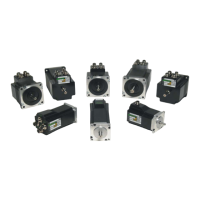JVL Industri Elektronik A/S - User Manual - Integrated Stepper Motors MIS23x, 34x, 43x 273
12.3 How to connect the motor
12.3.3 Serial Connection
Using serial connection of the phases, a motor provides the same performance (up to
1kHz) as parallel connection, but using only approximately half the current. This can in
-
fluence the selection of Controller model and enables a Controller rated for a lower mo-
tor current to be used. See illustration on previous page.
If the phases of a 4-phase step motor are connected in series, the motor’s rated phase
current should be divided by 1.41. For example, if the rated current is 4.2A, the maxi
-
mum setting of the Controller phase current must not exceed 3 A when the motor phas-
es are connected in series.
12.3.4 Parallel Connection
With parallel connection of motor phases, a motor will provide better performance at
frequencies greater than 1kHz compared to serially connected phases, but requires ap
-
proximately twice the current. This can influence the choice of Controller since it is nec-
essary to select a Controller that can supply twice the current used for serial phase
connection. See illustration on previous page.
When the phases of a 4-phase motor are connected in parallel, the specified rated cur-
rent of the motor must be multiplied by a factor of 1.41. For example, if the rated current
is 2.0A, the maximum setting of the Controller phase current must not exceed 2.83A
when the phases are connected in parallel.
It should be noted that the lower the self-induction of the motor the better, since this
influences the torque at high speeds. The torque is proportional to the current supplied
to the motor.
The applied voltage is regulated by the Controller so that the phase current is adjusted
to the selected value. In practice this means that if a motor with a large self-inductance
(e.g. 100mH) is used, the Controller cannot supply the required phase current at high
speeds (high rotational frequencies) since the output voltage is limited.

